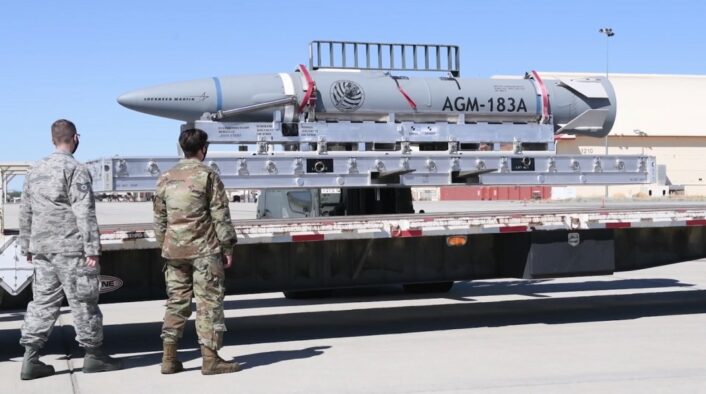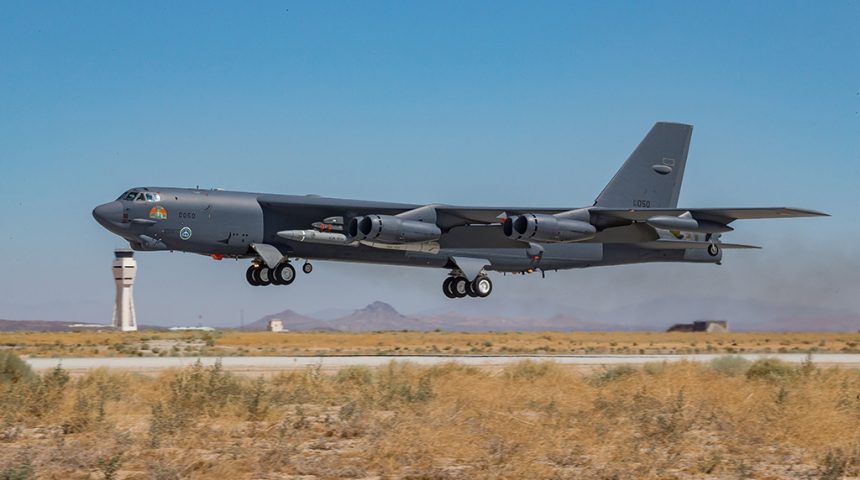The weapon’s booster ignited and burned for the expected duration, achieving hypersonic speeds.
The U.S. Air Force announced that it finally successfully released an AGM-183 Air-launched Rapid Response Weapon (ARRW) from a B-52H Stratofortress off the Southern California coast on May 14, 2022. Contrary to the previous three attempts, where the ARRW was not released in two occasions and did not fire its engine in the only successful release attempt, the weapon this time correctly separated from the aircraft and ignited its booster.
The press release did not disclose any significant detail, other than acknowledging that, following the separation from the B-52 bomber, the ARRW’s booster ignited and burned for an unspecified expected duration, achieving hypersonic speeds five times greater than the speed of sound (Mach 5). The speed mentioned in the press release is not to be taken as an exact indication, as the maximum speed of the AGM-183 is expected to be well in excess of Mach 5.
Even if sometimes it is argued that the hypersonic speeds region goes from Mach 3 onwards, from an engineering point of view the value that separates supersonic speeds from hypersonic speeds is Mach 5. This is because, from Mach 5 onwards, the energy of the hypersonic object is enough to cause chemical variations in the molecules of the airflow surrounding it, with nitrogen and oxygen being mainly affected.
“This was a major accomplishment by the ARRW team, for the weapons enterprise, and our Air Force,” said Brig. Gen. Heath Collins, Air Force Program Executive Officer for Weapons. “The team’s tenacity, expertise, and commitment were key in overcoming the past year’s challenges to get us to the recent success. We are ready to build on what we’ve learned and continue moving hypersonics forward.”
Like the previous attempts, the test was conducted by a B-52 belonging to the 419th Flight Test Squadron and the Global Power Bomber Combined Test Force, both at Edwards Air Force Base. As we mentioned in other occasions, the B-52 is planned to become the first bomber in the US arsenal to receive hypersonic weapons, followed by the B-1B Lancer.
“The test team made sure we executed this test flawlessly,” said Lt. Col. Michael Jungquist, 419th FLTS commander and GPB CTF director. “Our highly-skilled team made history on this first air-launched hypersonic weapon. We’re doing everything we can to get this game-changing weapon to the warfighter as soon as possible.”

While it has not been explicitly mentioned in the press release, the test is supposed to have taken place over the Point Mugu Sea Range, where also the previous attempts were performed. Like happened for the previous test flights, a NASA WB-57F aircraft, often used to film missile and rocket launches, was spotted flying in the area on May 14, 2022, via flight tracking websites.
The AGM-183A ARRW is based on hypersonic glide vehicle technology derived from the Air Force and Defense Advanced Research Projects Agency (DARPA) Science and Technology (S&T) Demonstration known as Tactical Boost Glide (TBG). A fragmenting glide vehicle is launched from a conventional rocket, or more precisely a Solid-Rocket Motor (SRM) booster, to the upper atmosphere and, once it reaches hypersonic speeds, it separates from the rocket and glides to its target at speeds up to Mach 15. At these speeds, there is no need for a conventional explosive warhead as the kinetic energy alone delivered during impact would be enough to destroy most targets.
The Air Force also defines the ARRW as an “operational hypersonic air-launched weapon enabling the U.S. to hold fixed, high value, time-sensitive targets at risk in contested environments from standoff distances.” The missile will provide a survivable, lethal, long-range strike capability to go after high-end capabilities of a potential adversary, such as deep-inland strike against targets of strategic importance and coastal strike against high-end systems.
These characteristics are a consequence of the extremely high speed and the capability to maneuver the glide vehicle away from threats (InterContinental Ballistic Missiles lack this capability and thus are more predictable) which, in turn, make the weapon almost impossible to intercept.
The setbacks experienced last year almost brought the program to an end, with an abrupt reduction in the ARRW’s budget for FY2023. In fact, during its first ever launch attempt in April 2021, the missile failed to separate from the B-52’s pylon, failed to ignite its booster after separation during the second attempt in July and failed to separate again during the third attempt in December.
In fact, compared to the initial proposal, the Fiscal Year 2023 budget request shows a request for $46.6 million to buy only one AGM-183A missile throughout the year. “[We’re] not walking away [from ARRW]. It’s funded in FY 23,” Maj. Gen. James Peccia, Deputy Assistant Secretary of the Air Force for budget told reporters during a press conference for the budget requests disclosure. “And then we’ll make an assessment after that.”









